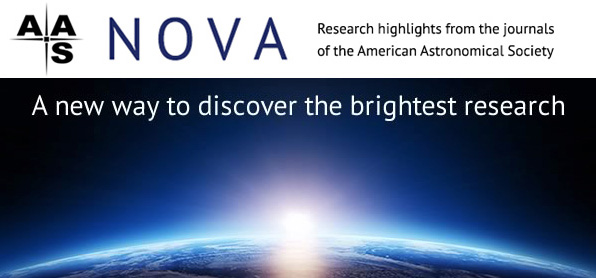Highlights from AAS Nova: 2-15 October 2016

Susanna Kohler American Astronomical Society (AAS)
AAS Nova provides brief highlights of recently published articles from the AAS journals, i.e., The Astronomical Journal (AJ) and The Astrophysical Journal (ApJ), ApJ Letters, and ApJ Supplements. The website's intent is to gain broader exposure for AAS authors and to provide astronomy researchers and enthusiasts with summaries of recent, interesting research across a wide range of astronomical fields.
The following are the AAS Nova highlights from the past two weeks; follow the links to read more, or visit the AAS Nova webpage for more posts.
14 October 2016
An Interview with Melissa McGrath
Next week we’ll be at this year’s DPS/EPSC meeting in Pasadena, CA! In preparation, we talked with Melissa McGrath, the new AAS Lead Editor for the Solar System, Exoplanets, and Astrobiology corridor.
12 October 2016
How Did Our Galactic Nucleus Form?
The recent discovery of old, variable stars in the Milky Way’s nucleus may have solved a long-standing question.
11 October 2016
Why Are Pulsar Planets Rare?
Pulsar planets were the first planets outside the solar system ever discovered, but they now appear to be very rare. Astrobites reports on what makes pulsar planets so uncommon.
10 October 2016
Featured Image: X-Rays from the Dark Side of Venus
Imaging of Venus during its 2012 transit across the Sun revealed X-ray emission coming from the planet’s dark side. What was the source of this light?
7 October 2016
SMASH 1: A Disrupting Satellite of a Satellite?
The Large Magellanic Cloud, a satellite of our galaxy, may have a newly discovered satellite of its own — a faint collection of stars being torn apart by the Cloud’s gravitational forces.
5 October 2016
Merging a Pair of Supermassive Black Holes
When two galaxies collide and merge, what happens to the supermassive black holes that reside at the galaxies’ centers?
4 October 2016
Gravity-Darkened Seasons on Planets
What happens when a planet orbits a rapidly spinning, oblate star? Astrobites reports on how this can potentially double the number of seasons that a planet experiences!
3 October 2016
A Solution to “Too Big to Fail”
Why aren’t the outputs of cosmological simulations consistent with the satellite galaxies we observe around the Milky Way? A recent study may have found an answer.


